THOUGHTS ABOUT NOAH’S FLOOD
It now seems that now most scholars agree that Noah’s flood was not worldwide but a localized flood. As with the location of Atlantis, there are many locations identified by these scholars.
With all the different views on where Noah’s flood was, I reread an old (1934) book “Tracing Our Ancestors” by Frederick Haberman. This book, among many subjects, locates the Garden of Eden, the area where the Adamites lived and the place of Noah’s flood. Also see the maps reprinted from Haberman’s book.
I also went to Google Earth to see if the Global Positing Satellite could detect the area. Yes it is still there (see maps). The first map is a satellite view of the area as seen from space. The second map is a terrain map showing the mountains more clearly and marking the portion of those mountains that collapsed.
Most of the "preachers" talk about the garden being in Iraq, but their conclusions are illogical because if the garden was in Iraq the mountain Noah which landed would have to be in Iraq. Most say that it was Ararat which is north of Iraq in Armenia. This mountain will not fit the story because it projects up out of a plain and if there was a flood there, it would have to have been worldwide (proven now that it could not have been worldwide). Also, Ararat means “the highest peak” not just a mountain in Armenia.
The bible tells us exactly where the Garden of Eden was and nails it down with the descriptions of the rivers. Phisom, Geon, Tigris and Euphrates. These rivers are still there as described in the Bible but the names have changed. Rivers with similar names were named northwest of the Persian Gulf, i.e., the Tigris and Euphrates. The Garden of Eden was on the Pamir Plateau and when Adam left the Garden of Eden, he went eastward into Tarim Pendi (basin), China. That area was surrounded by mountains and the area within was at a prefect altitude for constant weather and was full of springs from the mountains roundabout. The area now has changed in elevation and is a desert. When the flood came it filled the basin and Noah floated out and to the west. Then the entire back side of the mountain range fell down and drained into Mongolia to the East the scars of which are still there. When he walked down the mountain, the Chinese, from the book of the Shu-king, the Chinese Noah, speaks of Fu-hi who was born in a rainbow about 2355 BCE. Chinese writings go back about 3,000 to 4,000 years BCE and the flood was about 2344 BCE.
Noah and his group walked off one of those Ararats (the highest peak) and into populated areas. He migrated southwest down to the inhabited city of UR of the Chaldeans sometime after 2344 BCE. UR of the Chaldeans is the city where Abraham was born. Once a coastal city near the mouth of the then Euphrates river on the Persian Gulf, UR is now well inland.
In 1980, a Chinese expedition to find “The Lost City of Loulan” (north-eastern edge of the Lop Desert [Tarim Basin]) found the mummified remains of a 40 year old, brown haired woman with obvious Caucasian traits in an immaculate state and radiocarbon dated her remains to be approximately 3,800 years old. This is the area where the Pe-Shan range collapsed into the Mongolia. In close proximity to this so-named “Loulan Beauty”, there was another mummy in a tomb constructed of wood that carbon dated as early as 6,000 B.P. (4,050 B.C.E.).
Mair states in his book that "the earliest mummies in the Tarim Basin were exclusively Caucasoid, or Europoid" with East Asian migrants arriving in the eastern portions of the Tarim Basin around 1000 B.C.E. In trying to trace the origins of these populations, Victor Mair's team suggested that they may have arrived in the region by way of the forbidding Pamir Mountains about 5000 years ago. This is the area of The Garden of Eden and the timing is about the time of Adam being sent out of the Garden of Eden to the east.
This remains controversial. About the controversy, Mair has stated that:
The new finds are also forcing a reexamination of old Chinese books that describe historical or legendary figures of great height, with deep-set blue or green eyes, long noses, full beards, and red or blond hair. Scholars have traditionally scoffed at these accounts, but now it seems that they may be accurate.
__________________________________________________________________________________
Among the many facts outlined in Charles A. Weisman’s book “Facts & Fictions Regarding Noah’s Flood” he points out that many of the world’s oldest civilizations had no worldwide flood at the time of Noah.
This card shows the six oldest civilizations:
DATE B.C.E. |
2600 to 2500 |
2400 to 2300 |
EGYPT |
Cheops rules – builds Great Pyramid at Giza 5th Dynasty (2450) |
Unis King (2400)
Pepi 1 King - 6th Dynasty (2300 – 2200) |
MESOPOTAMIA
And ASIA MINOR |
Shara temple & gypsum statuettes at Tell Asmar. Troy II (2500 -2100) |
Sargon I unites Mesopotamia, establishes Akkadian Empire (2400 -2270) |
CHINA |
Huang-ti, the “Yellow Emperor” rules 2697 Black Pottery cultures |
Tao Dynasty (2356 -2255) Shun becomes emperor |
INDUS VALLEY |
King Asa-Manja rise to advanced civilization |
Harappa culture (2500 -1700) King Kusha. King Basu II |
PHOENICIA AND PALESTINE |
Early Philistine cities. Phoenicians sail to Greece and Britain. |
Proto-canaanite tribes infiltrate Palestine. Tyre and Sidon established. |
MINOAN AND GREECE |
Early Minoan I Period in Crete (2500 -1950).King Minos of Crete. |
City of Knossos established. Hieroglyphic writing used. |
Noah’s flood was from 2345 to 2344 B.C.E.
This is a reprint of “TRACING OUR ANCESTORS” the third chapter by: Frederick Haberman
Chapter III WHERE WAS THE DELUGE?
Orthodoxy has held until this day to the belief that the Deluge of Genesis was universal, covering the whole of the globe; yet such a belief, although apparently expressed by the translators, is, according to a careful analysis of certain facts of Scripture, an impossibility, to say nothing of the recorded facts of Egyptian and Chinese history, nor the impossibility presented by physical science. Once the question of the Deluge is settled another of the obstacles over which the critics and the scientists have stumbled is removed.
According to Ussher's Bible Chronology the Deluge occurred in the year 2348 B.C. This is correct to within four years, as Mr. Davidson has found from his careful analysis of Chinese, Babylonian, Hebrew, and Egyptian records, presented in his work, "Early Egypt, Babylonia and Central Asia." The correct date for the Deluge is from November 1, 2345 (Genesis 7:11), to November 11, 2344 B.C. (Genesis 8:14). Our Halloween and All Soul's days are still kept in commemoration of the Deluge.
Let us now analyze our data. If the Deluge had been universal as orthodoxy assumes it to be, then only Noah's family, consisting of eight persons, was left alive on the whole globe. Bible chronology shows that Abraham was born about the year 2000 B.C., in UR of the Chaldeans, and ancient Chaldea was at that time a flourishing country with a large population and a certain civilization, as the excavations have shown. It is out of all reason to assume that such a population could have developed from only eight people 350 years previously. Again, as soon as Abram had been called into Canaan (Genesis, 12th chapter) he went at once into Egypt to buy grain; and there too was established a great civilization and dense population. Senusert III of the 12th Dynasty was Pharaoh at that time.
If, as some people believe, the Great Pyramid was built by Shem or Melchizedek, it was built within only two or three centuries after the Deluge, and how could Egypt have furnished the Pyramid builders with 100,000 men every three months if all human beings were destroyed by the Deluge only two centuries before?
Professor Sayce found in a tomb of the XVIIIth Egyptian Dynasty at Thebes, which ruled about 1700 B.C., pictures of Negroes, as they are today; white-skinned Aryans; brown Egyptians; and typical Mongolians. As those four types of races have remained the same in all the thirty-six centuries since then, is it reasonable to suppose that those four types could have developed during the six preceding centuries and from the eight white-skinned survivors of the Deluge?
On the ceiling of the temple of Denderah in Upper Egypt was found one of the few existing ancient representations of the constellations of the Zodiac, engraved in copper, on it we find the various star clusters grouped into constellations represented by human or animal figures, such as: Virgo, Gemini, Bootes, Cassiopeia, Leo, etc. Every one of the major groups represented by human figures show men and women of our Caucasian or Aryan type, entirely different from the Egyptian type. All these evidences show that the Egyptians were not of the Adamic or White Race, but were a separate people who had lived in the valley of the Nile for over 50,000 years B.C., as Professor Brested has found, living a primitive existence until the Pyramid age, when members of the Aryans came among them and the Egyptian civilization suddenly burst forth, as we find from its ruins.
The first Egyptian Dynasty began in 3001 B.C., with King Mena, and an uninterrupted succession of Dynasties followed until the 12th which ended in 2146 B.C., as Mr. Davidson has established. The kings of the first Dynasty instituted a series of Renewal or Sed periods of thirty years each, which they derived from an earlier civilization. At the end of each period the co-regent was appointed to carry on the succession, as "the king never dies." The last of these Sed Festivals, the 35th, was celebrated in the 2nd year of Nebtaura, the last king of the 11th Dynasty, in 2057 B.C., as Mr. Davidson has established in his "Early Egypt, Babylonia, and Central Asia, Chart 14. The Deluge took place in 2344 B.C.; it fell in the reign of Pepi II, between the 25th and 26th Sed Festival. There was an uninterrupted succession of kings for 1247 years for the first twelve Dynasties and an uninterrupted series of Sed Festivals for the first twelve Dynasties and an uninterrupted series of Sed Festivals from 3378 to 2057 B.C. Egypt felt nothing of the Deluge and knew nothing of it until the story was brought to them years later by the survivors. (Recer also the author's Coordinated Chronology of Israel and Egypt).
Thus Egyptian chronology proves that no Deluge covered that land. As Genesis 7:20 tells us that the waters stood sixty feet above the mountain tops, and some of the mountains are over six miles in height, the waters of the Flood would have covered Egypt six miles deep. There is not enough water or moisture in existence on all the earth to accomplish that. If it did, it would have taken Egypt and every other country centuries to recover from such a catastrophe. As it is certain that no Deluge was in Egypt, there could therefore have been no universal Flood. It is useless for our friends, the Fundamentalists, to get vexed on this point and quote Scripture, which says that the earth was covered and all flesh died. The Word also says in Luke 2 "that all the world should be taxed." What is meant by this order is that all the world under Roman rule should be taxed. Rome's rule did not reach into China nor into America, and if it had the Americans would have rebelled.
When Genesis, therefore, speaks of the Flood covering the earth, it means that part of the earth in which the Adamites lived who sinned against God. The Negroes and the Mongols at that time did not know God's laws, and "where there is no law, there is no transgression," says Paul.
Valuable information we get from the Chinese sacred book of the Shu-king, which speaks of Fu-hi, the Chinese Noah. Fu-hi was "born of a rainbow;" of him it was also said that he bred and saved seven kinds of animals to be used as a sacrifice. The Chinese Shu- king, translated by W. Gorn-Old and referred to by Davidson, places the date of the Chinese Deluge within the reign of the Emperor Yaou, from 2356 to 2254., which period includes the Hebrew Deluge date of 2344 B.C. Moreover, according to Mr. Gorn-Old, the Shu-king gives the Epoch of Fu-hi as 2944 B.C., which is 1056 A.K., from 4000 B.C., the beginning of Adamic Chronology. A compilation of the dates of the Patriarchs in Genesis 5 will show that Noah was born in the 1056th year from 4000 B.C., or 2944 B.C. As this is the identical date of the Epoch of Fu-hi, the identity between Fu-hi and Noah is established. Genesis 7:11 states that the Flood commenced in the 600th year of Noah's life, which added to 1056 A.K. gives the Deluge again as 1656 A.K., or 2344 B.C.
In our previous chapter we have seen that the geographical description and Asiatic tradition fixes the Pamir Plateau as the location of the Garden of Eden. Genesis 3:24 indicates that when Adam was driven out of Eden he was driven towards the East. The fourth chapter of Genesis tells us of the murder of Abel by Cain and of God's judgment upon Cain. In the 14th verse the latter answers: "Behold, thou hast driven me out this day from the face of the earth; and from thy face shall I be hid; and I shall be a fugitive and a vagabond in the earth; and it shall come to pass, that every one that findeth me shall slay me." Of whom was Cain afraid? Certainly not of his father and mother. Who was "every one?" A careful analysis of these words show that Cain was driven from one "earth" into another "earth," or rather, in plain English, from one country into another. "And Cain went out from the presence of the Lord, and dwelt in the land of Nod, on the east of Eden." This verse confirms it and the land into which he went was still further east, down the valley of the Kashgar river; and there he took a wife. If Adam and Eve and Cain were the only people on the earth at that time, as some folks believe, then how could Cain find a wife?
The simple answer is that Cain married a woman of the Turanian or Mongolian race, living in the land, and so did the later sons of Adam, for Scripture tells us that "the sons of God married the daughters of men." The Adamic superiority easily predominated above the other and by intermarriages among the first families soon established a race of its own, resulting in a raising of the physical standard ("There were giants in the earth in those days") and a lowering of the spiritual standard of the original Adam.
Tradition goes back before recorded history and has often proven to be more reliable than history. "Tradition can neither be made nor destroyed," said Benjamin Disraeli. The traditions of ancient Chaldea, Egypt, and China picture the first civilization as existing in a "world" surrounded by high mountains. On our Chart of Central Asia we find below the map a reconstruction of the Chaldean conception of the "world," taken from "The Dawn of Civilization," by Sir Gaston Maspero. Explaining this conception, the author says:
"The earth which forms the lower part of floor is something like an overturned boat in appearance, and hollow underneath ...The earth rises gradually from extremities to the center."
To this Mr. Davidson makes the following remark:
"This is obviously the explanation of what the Chaldeans supposed to represent the encircling seas. Just as obviously, the collapse of the crust of the central dome produced the effect described in Genesis VII: II as the breading up of the fountains of the deep."
The second figure on the Chart of Central Asia shows a cross section by D. Davidson of the Tarim Basin of Eastern Turkestan, enclosed by high mountain ranges of the Tien Shan on the northwest and the Kuen Lun on the south. It was on the Tian Shan range of the "heavenly mountains" that Fu-hi, the Chinese Noah, appeared after the Deluge, surrounded by a "rainbow" and offering sacrifices of "seven pairs" of animals (Compare this with Genesis 8:20-22). It is in Eastern Turkestan that all the conditions exist that make possible the Deluge of Genesis and the destruction of all the inhabitants within their mountain-enclosed "earth" or country.
For an accurate description of this isolated part of the world, we turn to the Encyclopedia Britannica (11th edition) and the article, "Eastern Turkestan" which states:
"Though it is in reality an elevated plateau - it is nevertheless a depression when compared with the girdle of mountains which surround it on every side except the East, and even on that side it is shut in by the crumbling remains of a once mighty mountain system, the Pe-Shan...The mountain ranges which shut off East Turkestan from the rest of the world rank among the loftiest and most difficult in Asia, and indeed in the world... During the later Tertiary period all the desert regions would appear to have been covered by an Asian Mediterranean, or at all events, by vast fresh-water lakes, a conclusion which seems to be warranted by the existence of salt-stained depressions of a lacustrine character; by traces of former lacustrine shore lines, more or less parallel and concentric; by discoveries of vast quantities of fresh-water molluse
shells, the existence of dead poplars, patches of dead and moribund tamarisks, and vast expanses of withered reeds, all these crowning the tops of the jardangs, never found in the wind-scooped furrows; the presence of ripple marks of aqueous origin on the leeward side of clay terraces and in other wind-sheltered situations; and in fact, by the general conformation, contour lines, and shapes of the deserts as a whole. From the statements of old travellers, like the Venetian Marco Polo (13th century) and the Chinese Pilgrim, Hsuan Tsang (7th century), as well as other data, it is perfectly evident, not only that this country is suffering from a progressive desiccation, but that sands have actually swallowed up cultivated areas within the historical period."
To this description Mr. Davidson adds in his valuable work, "Early Egypt, Babylonia, and Central Asia," Chart 22:
"Now the only landlocked mountain-encircled area satisfying all the conditions is the mountain-encircled basin of Chinese (or Eastern) Turkestan. Here the Eastern barrier - the former mighty Pe-Shan range of mountains - has been crumbling at a rapid rate since a date long before the beginning of the Christian ear; crumbling under the action of 'desiccation,' on a large scale, and at a rate practically unknown elsewhere on the earth. The latter phenomenon forms one of the outstanding branches of investigation still of special interest and attraction to the geologist who specializes in phenomenal changes of this nature. With this phenomenal factor governing the conditions of change in the physical characteristics of Chinese Turkestan, it may be that the vast inundation in this basin, ascribed by geologists to 'the later Tertiary period,' actually occurred within the historical period (text of Chart No. 23). All the other indications point to the inundation here being that of 2345 B.C., according to the account of Genesis, the chronology of Egypt, and the tradition and date of the Chinese. This would explain the many legends still current in Chinese Turkestan of the many cities there said to have been buried under a rain of 'sand' as a Divine punishment for their inhabitants having ridiculed 'a holy man' who had rebuked them for their sins. (C.P. Skrine, 'Chinese Central Asia, pp. 189-190) Apparently the same earth movement that produced the earth- crust collapse in East Turkestan - converting the whole basin into an inland fresh-water sea - produced a slow settlement of the land surface from East Turkestan towards the Yellow Sea, causing inundations from the Hwang-Ho and its ancient delta of nine channels. The draining off through mountain fissures and channels and along the augmented streams flowing into China would also maintain throughout each year, for several generations, a supply above the normal. Thus, in 2286 B.C., 58 years after the Deluge in East Turkestan, the Emperor Yaou, in the Chinese 'Shu-king,' is represented as appealing for 'one of ability' to undertake the controlling of 'the ever-increasing flood' which 'is disastrous; spreading abroad, it encompasses the hills, and overtops the earthworks; vast and extensive it rises to heaven, the lower people sorrowing greatly.' In a footnote to his translation, Book II, Section 1, Dr. W. Gorn-Old states, 'Wang-hwant, the historian, says that 'formerly the heavens rained down incessantly, the wind blowing from the North East, and the ocean overflowing the land, submerged the country, and obliterated the course of the Nine Rivers.' Here we have the connection between the conditions of the primary Deluge and the inundation in China."
The Deluge of Genesis, therefore, was clearly the catastrophe that overwhelmed, according to the ancient tradition of East Turkestan, the "Forty cities of the Takla Makan." Not until the 3rd century B.C. did human habitation begin again in this deserted area; and there it lasted for only a few centuries, when the sands of the crumbling Pe-Shan range and the Gobi desert covered that ill-fated land again.
"...It may be, then, that in the days when Sargon reigned in Babylon and Menes on the Nile, wide fertile lands and populous cities with a culture and art of their own basked in the Central Asian sun, and that the glory and the wealth of a forgotten civilization lie hid for ever under the gigantic dunes of the Takla Makan." (Chinese Central Asia, pp. 190-192)
Our Chart shows that this landlocked Adamic "earth," about one thousand miles in length, was situated east of the Garden of Eden, located in a valley of the Pamir Plateau. The mighty seismic disturbances that brought about the collapse of the Adamic "earth" and the Deluge no doubt also brought great changes to the original Paradise, rising it into the highest plateau on earth and thus changing its climate. When "the highest peaks of the mountains" were covered, water overflowed into the surrounding countries and stranded Noah's Ark on Ararat, which means "the highest peak."
When Noah and his family moved into the plains of Shinar and the story of the Flood was told, the people of that country in after years naturally imagined that it was on the highest mountain to the north of them that the Ark rested and named the mount "Ararat." So also did the historic Euphrates derive its name from an eastern stream of Eden, in the same way that the English and Dutch settlers in America brought names of their fatherland with them.
Credits
Tracing Our Ancestors, by Frederick Haberman
The Association of The Covenant People
1338-A Seymour Street
Vancouver, 2, B.C.
Facts & Fictions Regarding Noah’s Flood, by Charles A. Weisman
Weisman Publications
P. O. Box 240844
Apple Valley, MN 55124
References
- Mallory, J. P.; Mair, Victor H. (2000), The Tarim Mummies: Ancient China and the Mystery of the Earliest Peoples from the West, London: Thames & Hudson .
- Barber, E. J. W. The Mummies of Urumchi; New York: W. W. Norton & Company, 1999.
External links
Foot Notes


One of the most famous Tocharian mummies found, the so-called "Beauty of Loulan" and right, her face as reconstructed by an artist.
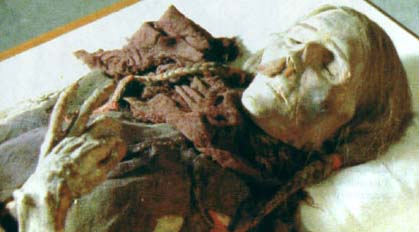
A Tocharian female mummy with long flaxen blonde hair,
perfectly perserved in braided hair. Items of weaved
material, identical to Celtic Cloth.
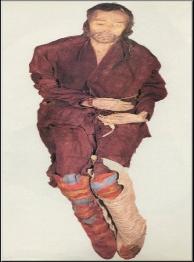
A Tocharian man with red-blond
hair; his clear European
features still visible after lying
nearly 3,500 years in his desert
grave in China.

Tocharian male mummy. To his right is a swastika decoration found on
his helmet recovered from the Tocharian grave sites.
The swastika was part of the original Indo-European language, meaning
"well being".


Other Red sHaired Mummies of China
T. J. Du Puy
tj@depodio.com
www.depodio.com/noah
The Taqrin Basin as it is today (satellite photos)
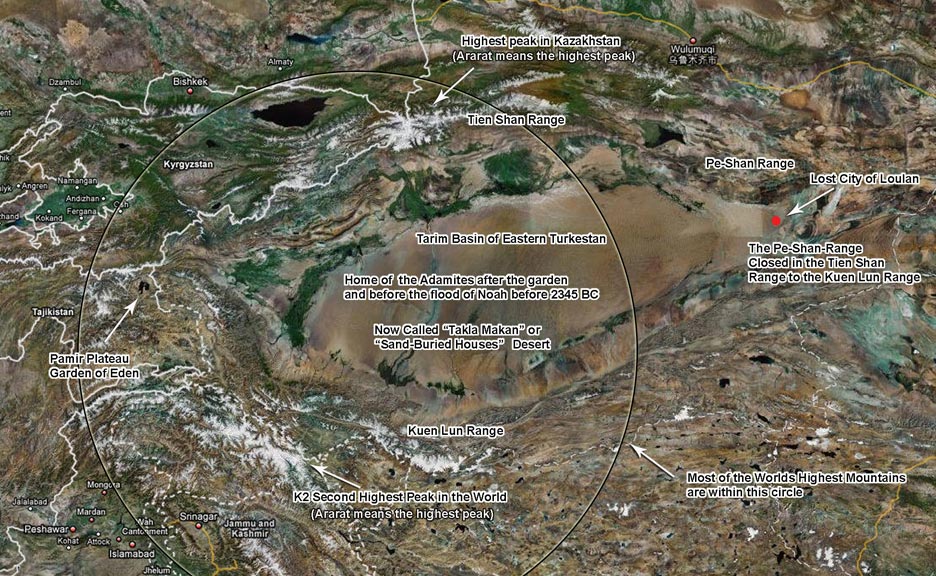

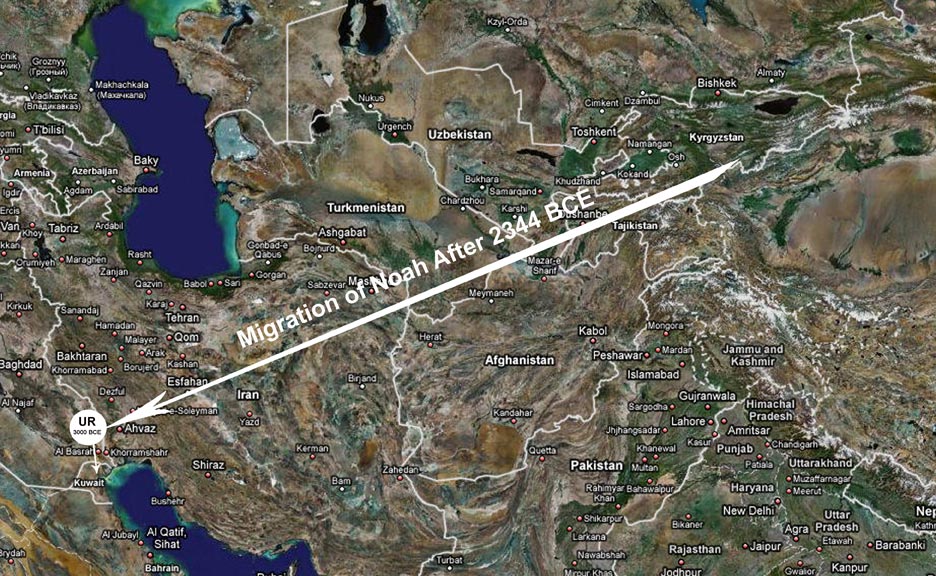
Frederick Haberman's charts
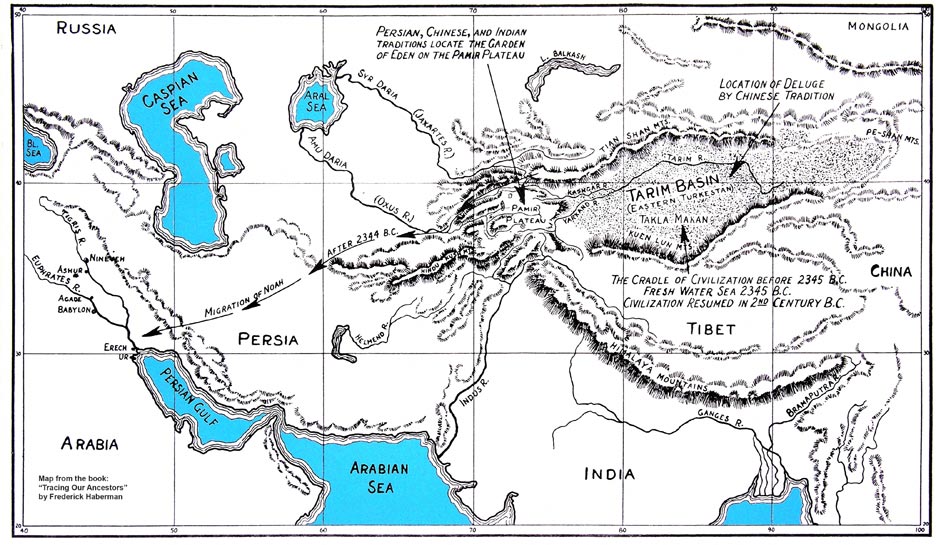

T. J. Du Puy
tj@depodio.com
www.depodio.com/noah











